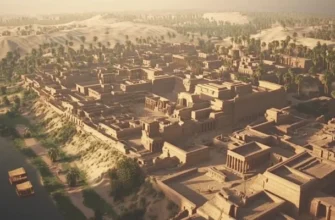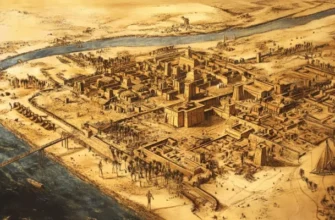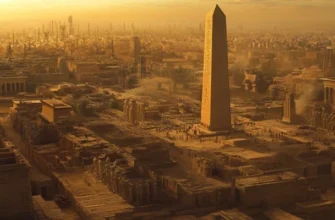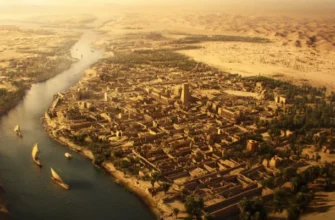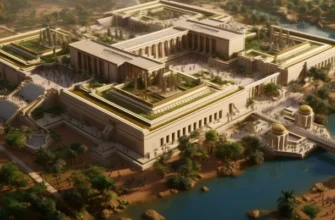Memphis was one of the most important cities in Ancient Egypt, serving as the capital for a long time, especially during the Old Kingdom (2686-2181 BC). Located west of the Nile, near modern Cairo, Memphis was not only a political but also a religious and cultural center that was crucial to the development of Egyptian civilization.
According to legend, Memphis was founded by King Menes, who united Upper and Lower Egypt. The city became an important administrative center, and it was here that the palace of the pharaohs was located. In addition, Memphis was home to numerous temples, the most significant of which was the temple of the god Ptah, the patron saint of the city, who was worshipped for centuries.
Religiously, Memphis was considered a sacred city. It was home to important shrines and a place where grandiose architectural monuments were created, including huge statues and pyramids. Memphis became a cultural center where art, science, and literature developed.
Over time, in particular after the decline of the Old Kingdom, the capital of Egypt was moved to other cities, such as Thebes, but Memphis remained an important religious and cultural center for many centuries.
Today, the ruins of Memphis are an object of archaeological research. They give an idea of the greatness and scope of the ancient Egyptian civilization. Memphis left a deep mark on the history of Egypt and human culture, and its legacy is still being studied by archaeologists and historians.
- History and foundation of Memphis
- The legend of the foundation of Memphis
- The role of Memphis in the history of Egypt
- The political center of Ancient Egypt
- Religious center and the cult of the Bird
- A cultural and scientific center
- Memphis as a religious and cultural center
- The deity Bird is the patron saint of Memphis
- Memphis as the center of the cult of the Bird
- The role of the Bird in the development of culture and art
- The Bird and the Pharaohs
- Architectural and cultural achievements of Memphis
- The decline and legacy of Memphis
- Reasons for the decline of Memphis
- Memphis’ legacy in the modern world
- Conclusion
History and foundation of Memphis
Memphis, one of the oldest cities in Egypt, has deep historical roots. Its foundation, according to legend, is attributed to the first pharaoh of Egypt, Menes (or Narmer), who united Upper and Lower Egypt around 3100 BC. Memphis became a symbol of the country’s unity and was chosen as the capital of the united Egypt because of its strategic location, close to the Nile and important trade routes.
The legend of the foundation of Memphis
According to ancient Egyptian legends, the founding of Memphis is attributed to Pharaoh Menes (or Narmer), the first king to unite Upper and Lower Egypt around 3100 BC. Legend has it that Menes chose the site of the city on the border of the two parts of Egypt to symbolize the unity of the country. This decision was also of strategic importance, as Memphis was located near the Nile, which provided convenient access to waterways and facilitated trade.
Another part of the myth concerns the god Ptah, who was considered the patron saint of Memphis. Ptah was the god of creativity and crafts, and his cult was extremely important to the city. Memphis was often associated with his image, and the temple of Ptah became one of the largest religious centers in Egypt. According to mythology, the Bird “created the world with his word,” and so the city became a sacred center of creativity and divine order.
From the very beginning, Memphis played an important role as a political and religious center. Marking its place as the capital of a united Egypt, Memphis became the seat of the pharaohs who ruled the country for thousands of years. Its importance was reinforced by the fact that the city was home to religious temples, including the temple of the god Ptah, a deity who became one of the main ones in the Egyptian pantheon.
During the first period of the Old Kingdom (2686-2181 BC), Memphis was not only the capital, but also a cultural center where art, science, and administrative and social structures developed, which became the basis for the development of an entire civilization.
Archaeological excavations on the territory of modern Memphis allow us to explore the earliest stages of its history. The found artifacts and ruins testify to large construction projects that began during the reign of the first dynasty. One of the most important archaeological finds is the huge stone statues and temples that confirm the greatness and importance of this city in ancient times.
Thus, the founding of Memphis takes us back to the time of Egyptian unification, when this city became the heart of Egyptian statehood, culture and religion, laying the foundation for the development of one of the greatest civilizations in human history.
The founding of Memphis turns out to be a complex process that combines both real historical events and mythological ideas. The city was an important political, religious, and cultural center from the very beginning of its history, and its role in the development of Ancient Egypt is difficult to overestimate. Archaeological evidence confirms that Memphis was not only the capital of Egypt, but also the place where the foundations of Egyptian culture, religion, and civilization were created.
The role of Memphis in the history of Egypt
Memphis, as one of the first capitals of united Egypt, played an important role in the political, cultural, and religious life of the country for several millennia. Its importance for Ancient Egypt cannot be overestimated, as the city became a symbol of the unity, strength and greatness of Egyptian civilization.
The political center of Ancient Egypt
Memphis has been the capital of Egypt since the first dynasty (approximately 3100 BC), when Pharaoh Menes united Upper and Lower Egypt. This city was located at a strategic crossroads of important trade routes and had convenient access to the Nile, which ensured its economic prosperity.
As a political center, Memphis served as the seat of the pharaohs, who conducted administrative and judicial affairs. It was home to palaces and government offices that governed a vast state that stretched from the Mediterranean Sea to the southern territories of Nubia. Memphis was also the place where the pharaohs concluded important treaties, performed rituals, and celebrated great victories.
Religious center and the cult of the Bird
One of the main reasons for the importance of Memphis for Egypt was its role as a religious center. Memphis was considered the home of the god Ptah, one of the main deities of the Egyptian pantheon. Ptah was the god of creativity, crafts, and architecture, which especially emphasized the importance of the city for Egyptian civilization. Memphis was the center for numerous temples, the main one being the Temple of the Bird.
An important aspect of the city’s religious life was that Memphis was also the site of numerous burials of pharaohs and high-ranking officials. The city was chosen to host large pyramids and tombs, including the tomb of Pharaoh Teti in Saïs, which is an important part of the archaeological heritage. These tombs became part of the Egyptians’ religious beliefs, where the pharaoh continued to fulfill his role as an intermediary between the gods and the people after his death.
A cultural and scientific center
Memphis was also an important cultural and scientific center of ancient Egypt. A large number of texts, records, as well as literary and scientific works were stored in the city. Mathematical and astronomical knowledge, as well as medical practices, were developed here, which later became the basis for Egypt’s great achievements in these fields.
Memphis was home to a large number of artists, craftsmen, architects, and builders who made an important contribution to the development of Egyptian architecture. It was in Memphis that many typical architectural forms were developed, such as large stone statues, obelisks and monuments, which have become characteristic of Egyptian culture.
Development of Memphis in different periods
The Old Kingdom (2686-2181 BC): During this period, Memphis was the undisputed political and religious center of Egypt. The most magnificent monuments were built here, such as the Djoser pyramids in Saqqara and the huge Temple of the Bird.
Middle Kingdom (2055-1650 BC): Although the capital was moved to Thebes, Memphis maintained its role as an important cultural center. During this period, the city regained its strength, becoming one of the main centers of art and science.
The New Kingdom (1550-1070 BC): Memphis continued to be an important city, but no longer the capital. During the reigns of pharaohs from the Eighteenth Dynasty (such as Thutmose III and Ramses II), the city retained its importance due to its religious and cultural role.
The decline of Memphis
Memphis began to lose its importance during the Late New Kingdom and the Late Dynasties. The reasons for this were changes in the political structure of Egypt, in particular the relocation of the capital to other cities such as Thebes. Nevertheless, Memphis remained an important religious and cultural center even after that.
Today, Memphis is an excavation site that provides valuable archaeological evidence of the greatness of ancient Egyptian civilization. Archaeological sites such as pyramids, temples, statues, and tombs tell the story of the continuous development of culture, religion, and art that influenced many generations. Memphis was an integral part of Egypt, and its heritage continues to fascinate scholars and tourists around the world.
Memphis has become a symbol of the greatness and power of ancient Egypt. As the country’s capital, religious center and cultural center, the city left a deep mark on the entire history of civilization. Its role in the development of politics, religion, science, and art has defined it as an important factor in the formation of one of the world’s greatest civilizations.
Memphis as a religious and cultural center
Memphis was not only a political but also an important religious and cultural center of ancient Egypt. The city became home to numerous religious temples where the gods were worshipped, and a place where Egyptian culture, art, and science developed.
Religious center
Memphis was famous for its temple of the god Ptah, who was the patron saint of the city. Ptah was considered the god of creativity and crafts, and his cult in Memphis was one of the most important in all of Egypt. Memphis was often depicted as the “city of the god Ptah,” and many pharaohs sought to build huge temples and monuments dedicated to this deity. The Temple of Ptah housed numerous religious texts that taught about the creation of the world and divine laws.
In addition to Ptah, other important deities of the Egyptian pantheon were honored in Memphis, such as Thoth, the god of wisdom, and Osiris, the god of the afterlife. The city was also an important religious center for honoring the pharaohs, as the Egyptians considered their rulers to be divine beings who were supposed to communicate with the gods through rituals and prayers.
Cultural center
Memphis became an important cultural center due to its location and role as the capital of Egypt. The city became a place for the development of literature, science, and art. First-class architectural monuments, statues, and reliefs were created here, reflecting the richness of Egyptian culture. Memphis was home to outstanding architects, sculptors and artists whose work reflected the greatness of ancient Egypt.
Memphis also developed writing, in particular hieroglyphic writing, which was used to record important religious and administrative texts. The city became a center for the study of astronomy, mathematics, and medicine, which was supported by the knowledge passed down through generations of priests and scholars.
Architectural achievements
Memphis was famous not only for its religious monuments, but also for its remarkable architectural achievements. One of the main architectural landmarks of this city is the huge Temple of the Bird, built in the times of the Old Kingdom. The temple was the center of the city’s religious life and was a complex structure consisting of a courtyard, a god’s abode, and a shrine. Archaeological excavations have also revealed a large number of statues of pharaohs and deities that served to worship and support religious worship.
The importance of Memphis as a cultural center is also confirmed by numerous archaeological finds: various artifacts, tombs, reliefs and written documents that testify to the rich development of art, literature and science in ancient Egypt.
Memphis played a key role not only as a political center, but also as a religious and cultural center of Ancient Egypt. The city became a place of development of important religious rites, scientific achievements and artistic heritage. Its temple complexes, architectural monuments, and cultural achievements left a deep mark on the history of Egyptian civilization, which is still being studied today.
The deity Bird is the patron saint of Memphis
The bird was one of the greatest gods in the Egyptian pantheon, and it was his cult that made Memphis the religious center of ancient Egypt. He personified creativity, arts and crafts, and was the patron saint of architecture, builders and artists. In the city of Memphis, which was considered a sacred place of Ptah, his cult was extremely influential, and many pharaohs tried to build temples and statues in his honor, seeking his blessing for their reigns.
The image of the Bird
In Egyptian mythology, Ptah was usually depicted as a man with a falcon’s head or as a god holding a scepter and ankh, symbols of life and power. Sometimes it could be depicted with the head of a bull or as a human figure with the attributes of a craftsman or artisan. The bird was the personification of the “creative force” that creates and organizes the world. It is believed that he created the universe with his word, a symbol of wisdom and order.
One of the most widespread myths claims that the Bird “conceived” the world and created it through his linguistic abilities. According to this legend, the Bird not only created matter, but also gave it form, order, and structure. This explains why the Bird was the patron saint of crafts, as well as builders and architects who embodied the “light of creation” in material forms.
Memphis as the center of the cult of the Bird
Memphis was considered the heart of the cult of the Bird. The city was not only the capital of Egypt, but also an important religious center, where the huge Temple of Ptah, one of the largest and most famous temple complexes in ancient Egypt, was located. The temple, known as the Temple of the Bird, was built during the Old Kingdom, under the reign of Pharaoh Djoser (III Dynasty), and then greatly expanded by the pharaohs of the New Kingdom, such as Ramses II.
According to Egyptian beliefs, the temple of Ptah in Memphis was the place where the god was in spiritual unity with the pharaoh. The cult of Ptah had a huge impact on the life of Memphis and all of Egypt. Religious rituals were held annually to emphasize the divine order and the role of the Bird in creating and maintaining the universe.
The role of the Bird in the development of culture and art
Since the Bird was the patron saint of creativity, his cult was closely intertwined with the development of Egyptian arts and crafts. Architecture, sculpture, painting, and even music all flourished thanks to his blessing. Artists and craftsmen believed that their art reflected the divine order established by the Bird.
Memphis became the center of Egyptian art because of the large number of temples, statues, reliefs, and monuments created in honor of the god Ptah. Architects and builders who worked on the construction of temples and monuments considered themselves disciples of the god Ptah, which also symbolized their role in reproducing the divine order on earth.
The Bird and the Pharaohs
The pharaohs also associated themselves with the Bird, as they believed that it was he who provided them with the wisdom and power to rule. They often tried to demonstrate their closeness to the god through religious rituals and the construction of temples. This allowed them to consolidate their power and also guaranteed that the Bird would protect and bless them. Some pharaohs even referred to themselves as “friends” or “sons” of the Bird, which emphasized their divine origin and religious legitimacy.
The bird was not only a deity that symbolized creativity and wisdom, but also an important patron saint of Memphis, a city that became the spiritual center of Egypt. His cult is deeply rooted in Egyptian religion, science, arts, and crafts, and Memphis remained one of the most important religious centers in Egypt for thousands of years. The cult of the Bird had a significant impact on the development of Egyptian culture and left a deep mark on the history of Ancient Egypt.
Architectural and cultural achievements of Memphis
Memphis, as one of the main cities of Ancient Egypt, was not only a political and religious center, but also played an important role in the development of Egyptian architecture, art and culture. The city became the center of great architectural achievements and cultural achievements, many of which left a significant mark on world history. Here are some of the main architectural monuments and cultural achievements of Memphis:
- The Temple of the Bird in Memphis
One of the most important architectural landmarks of Memphis was the Temple of the Bird, dedicated to the god Bird, the patron saint of the city. The temple was built in the Old Kingdom and eventually became the largest and most important religious complex in Memphis. Located in the heart of the city, the temple was a complex architectural ensemble that included open courtyards, sanctuaries, obelisks, and statues. Important religious rituals were held here, and the temple was a symbol not only of religious power but also of the political greatness of Memphis.
Excavations show that the temple was known for its impressive scale and huge stone statues depicting pharaohs and gods. Over time, the temple of the Bird became a spiritual center for all of Egypt, and its importance remained even during periods when capitals were moved to other cities.
- The pyramids of Saqqara
Not far from Memphis is one of the most significant archaeological sites in Egypt, the Saqqara Peak. It is home to the Djoser Pyramid, the first stepped pyramid, which is one of the oldest stone structures in the world. Although Saqqara is located on the outskirts of Memphis, this landmark is closely linked to its cultural heritage. Djoser’s pyramid was built during the Third Dynasty and is an important part of the architectural evolution of Egyptian funerary complexes.
Saqqara was also the burial place of many pharaohs, as well as high-ranking officials and priests. Archaeological excavations in Saqqara continue to amaze researchers with numerous tombs and reliefs that demonstrate the level of skill of Egyptian artists and craftsmen.
- Statues and monuments
Memphis was also known for its huge statues of pharaohs and gods. One of the largest and most famous statues in Memphis is the Colossus of Ramses II, which was part of the Temple of Ramses in Memphis. This grandiose statue depicting Ramses II, more than 10 meters high, has become one of the symbols of the greatness and power of the Egyptian state.
Another famous landmark is the Sphinx in Memphis (sometimes called the “Sphinx of Memphis”), which is earlier than the one in Giza. The Memphis Sphinx had the same characteristics-it depicted a lion with the head of a pharaoh, symbolizing the combination of royalty and power.
- Arts and crafts
Memphis was an important center for the development of Egyptian arts and crafts. As a religious center, the city was the site of numerous religious artifacts – statues, amulets, reliefs, and tombs – that reflected important aspects of Egyptian culture and religion.
Egyptian artists of Memphis reached great heights in sculpture, especially in the creation of huge statues of pharaohs and gods. They used techniques that ensured impressive durability and realism of their works. One of the main characteristics of Memphis works was the combination of simplicity of form with grandeur and elegance.
Memphis was also an important center for the development of jewelry, ceramics, and textile production. Its artisans made elegant objects from precious metals and stones that became part of Egyptian crowns and funeral rituals.
- Literature and writing
Memphis also contributed to the development of Egyptian writing, in particular hieroglyphics. Memphis was one of the centers of learning and writing, where sacred texts, religious books, and administrative documents were produced and stored. Not only religious texts are important, but also administrative papyri containing records of economic life and political organization.
Memphis was not only the capital of Egypt, but also an important cultural and architectural center that gave the world numerous monuments and achievements that became the basis of Egyptian civilization. Huge temples, statues of pharaohs, magnificent art and high standards of crafts defined the cultural heritage of Memphis. Its architectural and cultural achievements not only cemented the importance of this city in history, but also made it one of the largest centers of ancient civilization.
The decline and legacy of Memphis
Memphis was an important political, religious, and cultural center of Ancient Egypt for many centuries, but after the collapse of the Egyptian state and changes in the political structure of the city, its status changed significantly. Despite the decline of Memphis as a capital, its cultural and religious heritage continued to influence subsequent eras, leaving a deep mark on the history of Egypt and the world.
- The decline of Memphis after the collapse of the Egyptian state
Memphis began to lose its role as the main political center in the late New Kingdom (16th – 11th centuries BC), when the capital of Egypt was gradually moved to Thebes. This process continued for several centuries as Thebes’ influence as a religious center became dominant.
During the so-called Third Transitional Period (XXI-XXVI dynasties), when the country was going through a period of disorganization, foreign conquerors, in particular the Libyans and later the Assyrians, began to influence Egyptian politics. Memphis was again in the shadow of new political centers such as Tanis and Sfendu.
After the conquest of Egypt by the Persians (VII century BC), Memphis finally lost its status as the capital. The Persian rulers chose new administrative centers, and Memphis became part of the vast territories of the empire. During the reign of Alexander the Great (IV century BCE) and his successors, Memphis remained an important economic and religious center, but the capital was moved to Alexandria, which marked the beginning of a new era for Egypt.
- The legacy of Memphis in subsequent eras
Despite the decline of Memphis as a political and administrative center, its cultural and religious heritage had a huge impact on subsequent eras and even on later civilizations.
Memphis remained an important religious center for a long time, and its cult of the Bird continued to influence religious practices even during the period of Hellenistic and Roman rule. The Romans, who came to Egypt after the conquest of Alexander the Great, revered the Bird and its cults, although already at this time Memphis lost its importance as a major religious center. However, until the end of the ancient period, Memphis remained an important place for the worship of the Egyptian gods.
Memphis also left an extremely rich architectural heritage that can still be seen today thanks to numerous archaeological sites. The pyramids and tombs preserved at Saqqara are important parts of Memphis’ architectural heritage. Memphis was a symbol of the greatness and power of ancient Egypt, and its architectural achievements, such as the Temple of the Bird and huge statues, became the basis for further architectural developments throughout the Egyptian world.
The decline of Memphis as a capital did not mean the end of its cultural influence. Architectural styles and technologies developed in Memphis were successfully transferred to new capitals such as Alexandria and Thebes. Memphis continued to be a symbol of Egyptian cultural heritage, which lived on in the monuments, temples, and works of art that were left behind after the city’s heyday.
Memphis had a great influence on the development of Egyptian culture and art in the Middle Ages, as well as on subsequent civilizations, in particular Arab culture, after the conquest of Egypt by the Arabs in the seventh century. The archaeological finds and monuments of Memphis, which have become part of the world’s heritage, attracted the attention of researchers and travelers during the Renaissance, when Egyptian culture gained new recognition.
In particular, the influence of Memphis is felt in the architectural and religious traditions that survived in the Roman and Byzantine eras. Religious symbols, such as obelisks, statues of deities, and even the idea of divine rule, left their mark on European and Asian culture.
- The archaeological significance of Memphis today
Memphis as an archaeological center is still important today. Its ruins, numerous temples, statues, and pyramids are an invaluable source of information about the culture and religion of ancient Egypt. The discovery of the archaeological sites of Memphis helped researchers understand not only the political but also the socio-economic aspects of Egyptian life in different periods of their history.
Of particular importance are the tombs and funerary complexes located in Saqqara, where numerous artifacts illustrating the evolution of Egyptian architecture and religion have been preserved. Archaeologists continue to work on the territory of Memphis and Saqqara, and new finds allow us to discover new aspects of the cultural heritage of Ancient Egypt.
Memphis experienced a decline as the capital of Egypt, but its cultural, religious and architectural heritage left an indelible mark on the history of the country and the world. The city, which was once the heart of Egyptian civilization, continues to influence science, art, and architecture. The archaeological sites of Memphis are invaluable sources that help contemporaries to better understand the culture and achievements of ancient Egypt.
Reasons for the decline of Memphis
The decline of Memphis, as one of the main political and cultural centers of ancient Egypt, was caused by a number of both internal and external factors. Although the city remained an important center of religion and culture, its former greatness began to gradually fade away in the late New Kingdom. Identifying the causes of Memphis’ decline allows us to better understand the processes that took place in Egyptian society during the transition from one era to another.
- Internal factors of decline
One of the main reasons for the decline of Memphis was political instability in the last periods of Ancient Egyptian rule. During the late New Kingdom (16th – 11th centuries BC), when the country was going through hard times due to the struggle with foreign enemies and internal contradictions, the Memphis region began to lose its importance as a political center.
During the Third Transitional Period (XXI-XXVI dynasties), the Egyptian state experienced serious upheavals: the struggle between local dynasties, the weakening of the central government, and numerous coups contributed to the disorganization of the political system. As a result, Memphis gradually lost its role as a capital city in favor of other centers, including Thebes and Tanis.
The decline of the central government had a negative impact on the Memphis economy. Egypt, in particular during the reign of the weak pharaohs, began to experience an economic crisis: rising taxes, weakening of the governance system, and reduced resources for the construction and maintenance of large temple complexes led to a deterioration in the economic situation. Memphis, as an important economic and trade center, also suffered from such changes, losing its strategic importance.
Memphis was an important religious center, in particular due to the cult of the Bird. However, over time, the importance of different deities changed, and religious practices began to be centralized in other cities, particularly in Thebes, where the cult of Amun was centered. The spread of the cult of other gods, as well as religious reforms, particularly during the reign of Akhenaton (18th Dynasty), weakened the religious significance of Memphis. Not only was the religious landscape changing, but also the political organization, which contributed to the weakening of Memphis as an important spiritual center.
- External factors of decline
One of the main external factors that influenced the decline of Memphis was the numerous foreign invasions and conquests. During the New Kingdom period and later eras, Egypt experienced numerous wars with various external forces that weakened the country and reduced the importance of Memphis. By the end of the third millennium BC, Egypt was attacked by peoples such as the Hyksos, who invaded Egypt and destroyed many of its cities, including Memphis.
During the later dynasties, in particular during the conquest of Egypt by the Persians (VI century BC), Memphis became part of the Persian Empire. This actually led to the loss of its independence and influence. Although it remained an important religious center, Memphis lost its political and economic stability, as the empire pursued a centralized policy and mostly used other cities to administer its territories.
The end of Memphis’s greatness came after the conquest of Egypt by Alexander the Great in 332 BC and the subsequent elitist (Greco-Roman) rule. Since the establishment of Alexandria, the new capital city, Memphis has gradually lost its importance as a political and cultural center. The Greco-Roman rulers paid more attention to Alexandria, which quickly became the cultural, economic, and religious center of Egypt. Memphis became only a shadow of its former greatness, despite the fact that religious worship and certain traditions continued to exist there.
- Natural disasters and climate change
However, the role of natural factors in the decline of Memphis should not be underestimated. Ancient Egypt experienced periodic climate changes that could lead to changes in the agrarian economy. Lowering the level of the Nile, droughts, or changes in the riverbed could lead to deteriorating agricultural conditions in and around Memphis, which in turn reduced the city’s importance as an economic center.
- Loss of capital status
The decline of Memphis was the result of a combination of numerous internal and external factors: political instability, economic hardship, religious changes, foreign conquests, and natural disasters. These factors combined to cause Memphis to gradually lose its status as the capital and political and cultural center of Egypt. However, despite this, Memphis was not forgotten, and its architectural, cultural, and religious achievements continued to influence subsequent eras, leaving an indelible mark on the history of Egypt and the world.
Memphis’ legacy in the modern world
Memphis, although it has lost its importance as the political and religious center of ancient Egypt, has left a vast legacy that is of great importance to modern science, archaeology, and cultural heritage. The legacy of Memphis continues to influence our understanding of Egyptian civilization, its religion, art, and architecture. Today, this city is one of the largest archaeological sites, attracting researchers and tourists from all over the world.
- Archaeological heritage of Memphis
Archaeological excavations in and around Memphis, especially in Saqqara, are an invaluable source of knowledge about ancient Egypt. The preserved monuments help to reconstruct not only the structure of the city, but also the everyday life of its inhabitants. One of the biggest discoveries is the pyramids and tombs of the pharaohs, which have become the main monuments of Egyptian architecture.
The pyramid of Djoser in Saqqara, one of the oldest and most famous pyramids in Egypt, is an invaluable archaeological site that has become a benchmark for future generations of architects.
The obelisks and statues of the Bird that have survived in Memphis are important elements of religious heritage and art that have influenced the architectural traditions of many cultures.
These monuments and artifacts give us an idea of the size and grandeur of ancient Egypt, as well as the importance of Memphis as a religious and cultural center.
- Memphis’ cultural influence on world heritage
As a center of culture and religion, Memphis played a significant role in the development of art, literature, and religious practices. The huge temples and religious complexes that have been preserved are the basis for understanding ancient Egyptian cults, rituals and beliefs. The importance of Memphis in the history of religion can also be seen in the way the cult of the Bird influenced other cultures.
Religious influence: Memphis was the center of the cult of the god Ptah, who was revered as the creator and patron of crafts. This cult influenced the development of religious iconography and ideas about the divine in many cultures that retained elements of Egyptian beliefs.
Art and architecture: The architectural traditions of Memphis, especially in the construction of temples, statues, and obelisks, influenced the development of architecture in the Roman and Byzantine worlds, as well as in the culture of medieval Europe, where there was a renaissance of interest in Egyptian symbols.
- Memphis in science and education
Modern scientific research of Memphis, its architectural monuments and artifacts has become the basis for the development of Egyptology. Archaeologists, historians, and specialists in other disciplines are actively researching the city and its heritage. Memphis has become an important site for university programs in Egyptology and the history of ancient civilizations.
Archaeological research: Modern archaeological expeditions continue to discover new sites, including tombs, statues, and religious artifacts. This allows us to better understand not only the religious life of Memphis, but also its economic and social structure.
Innovative technologies: The use of the latest technologies, such as laser scanning and radiography, allows us to study architectural structures and found artifacts without physically damaging them, which greatly enriches the modern understanding of the ancient civilization.
- Tourism and popularization of Memphis
Today, Memphis is a popular tourist destination that attracts visitors from all over the world. Cities like Alexandria and Cairo are located nearby, making Memphis accessible to travelers. Tourists can visit famous archaeological sites, including the pyramids at Saqqara, temples, and obelisks, which allows them to immerse themselves in the atmosphere of the greatness of ancient Egypt.
- Memphis in contemporary culture
Memphis also continues to influence modern culture. Reflections of Egyptian symbols and architectural elements can be found in art, music, cinema, and even popular video games. Egyptian symbolism, which comes from the culture of Memphis, is often used as a powerful symbol and source of inspiration in contemporary art and design.
The legacy of Memphis lives on to this day, leaving a profound impact on science, architecture, religion, art, and even modern cultural movements. Memphis continues to be a living testament to the greatness and achievements of ancient Egypt, and its contribution to world culture cannot be overstated. Archaeological excavations, scientific research, artistic heritage, and tourist interest in Memphis preserve and transmit its cultural value to future generations.
Conclusion
Memphis was not only the capital of Ancient Egypt, but also a key cultural, religious, and political center that played an important role in shaping Egyptian civilization. Founded as a center of power and knowledge, Memphis became a symbol of the greatness of the pharaohs and the development of Egyptian culture. The city was home to numerous architectural masterpieces, religious rituals, and scientific achievements that not only shaped Egyptian society but also left an indelible mark on human history.
Memphis had a huge impact on the religious beliefs and art of Ancient Egypt, in particular through the cult of the god Ptah, and became a symbol of Egyptian civilization for future generations. Its architectural monuments, such as the pyramids and temples, continue to fascinate researchers and tourists alike, and have become important sites for studying Egyptian history.
Despite its decline in later periods, Memphis’ heritage remains an integral part of the world’s cultural heritage. Today, Memphis is not only an archaeological treasure, but also a symbol of the power and greatness of one of the greatest civilizations in human history, which influenced the development of many cultures and sciences around the world.

